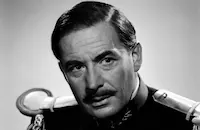Affair in Monte Carlo
Cast & Crew
Victor Saville
Leo Genn
Peter Jones
Cyril Smith
June Clyde
Mark Baker
Film Details
Technical Specs

Synopsis
At a small seaside hotel in Antibes, France, proprietor Monsieur Blanc returns from his wedding preparations to learn that his young fiancée has left him for a man she met the day before. Hotel guests are shocked and skeptical about the sudden romance, all except for American author Robert Stirling, as he has witnessed love-at-first-sight. He agrees to tell the story after securing his friends's promises they will reconsider the fiancée's case afterward. Robert relates that his story occurred before the war, when he anchored his yacht off Monte Carlo: Among the guests on Robert's yacht are his young cousin, Peter, who always brings uninvited guests aboard, film director Frank Brown and his wife Alice, and Linda Venning, a beautiful British widow whose husband had been a close friend of Robert. Robert administers the Venning estate while Linda continues her charitable work at home. Although Peter flirts with Linda, she is indifferent, but later that evening agrees to join Robert at the casino. As it is her first time at the casino, Robert encourages Linda to closely watch the gamblers' hands because they reveal stories. Linda is riveted by a young man whose hands reveal a deep anxiety as he loses. She follows the young man outside and, convinced that he is suicidal, urges him to step away from a bridge that overlooks the train tracks. When the young man reveals that he has no home or money, Linda rents him a room at a pension. The young man initially sneers at Linda's attempts to help him, but finally acknowledges that he is alone. Linda spends the night in the young man's room and overhears his desperate cries about a pair of diamond earrings. The next morning, she asks him about the earrings, and learns that he stole them from his aunt in Paris. The young man relates that his gambling habit started in his youth at his father's horse racing stable, and ruined his college career. The young man admits that the gambling is a disease; he is now desperate because he cannot afford to buy back his aunt's earrings from a pawn broker. Linda is overwhelmed by the enormity of the young man's problems and returns to the yacht. There she confides in Robert, asking him for a loan so she can help the young man out of debt. Linda locates the young man at the casino, where he reveals he has written a final letter to his father. She presses the money on him and urges him to retrieve the earrings and reform. The young man is rejuvenated by Linda's affection and they spend the afternoon touring the mountains. At a mountain chapel they are befriended by L'Abbe Benoit, a famed composer, and his mother. Inside the church, the young man makes a solemn vow to quit gambling. Benoit perceives that the couple is in love and accompanies them in their carriage back to town. When the young man steps out to buy his train ticket back to Paris, Linda confesses that she does not see happiness in their future, and she leaves without saying goodbye. The priest consoles the distraught young man, advising him that Linda only desires for his reformation as re-payment. Back on the yacht, however, Linda regrets leaving the young man and, gathering a few personal items, makes a dash for the train. Linda arrives at the station just as it pulls out and, after making a stop in the chapel to pray, returns to the casino. She is stunned to find the young man back at the roulette table. The young man is enjoying a winning streak, and when Linda begs him to leave and reminds him of his vow, he angrily shouts that she should leave him alone and throws his money at her. Robert witnesses the scene and escorts Linda out of the casino. Now back in Antibes, Robert notes that Linda tried to return to the young man but he had committed suicide. M. Blanc appears with a tray of drinks in order to drink to his former fiancée's happiness, and shortly afterward, Robert happily greets his wife, Linda, as she arrives.

Director
Victor Saville
Cast

Leo Genn
Peter Jones
Cyril Smith
June Clyde
Mark Baker
Moultrie Kelsall
Joan Dowling
Trader Faulkner
Isabel Dean
Peter Illing
Jeanne Pali
Peter Reynolds
Mara Lane
Robert Ayres

Merle Oberon

Richard Todd
Rene Poirier
Jacques Cey
Jacques Brunius
Stephen Murray
Marguerite D'alvarez
Virginia Bedard
Gordon Bell
Jill Clifford
Peter Hobbes
Victor Saville
Crew
Richard Best
Joan Bridge
Christopher Challis
Warren Chetham-strode
Ivan Foxwell
Freddie Francis
Robert Gill
Frederic Gotfurt
Philip Green
Fred Heatherton
Harold V. King
Louis Levy
John Redway
Constance Reeve
Gordon Scott
Cecil V. Thornton
Terence Verity
W. A. Whittaker
Polly Young

Film Details
Technical Specs

Quotes
Trivia
Notes
Opening and closing cast credits differ in order. The working titles of this film were Just For the Night, The Monte Carlo Affair and Twenty-Four Hours in a Woman's Life. The film was initially released in Great Britain in 1952 under the title 24 Hours in a Woman's Life. The British release ran for 90 minutes at a length of 8,070 feet, and included scenes featuring the Antibes hotel owner's fiancée, "Henriette," played by Yvonne Scatcherd, and "Georges," played by Pierre Le Fevre, the hotel guest with whom she falls in love and runs away. According to information in the file on the film in the MPAA/PCA Collection at the AMPAS Library, early versions of the script depicted the character "Linda Venning" as being a married woman having an affair. As noted by contemporary sources, the film was partially shot on location in Monte Carlo, with interiors being filmed at the Associated British Studios in Elstree, England.












